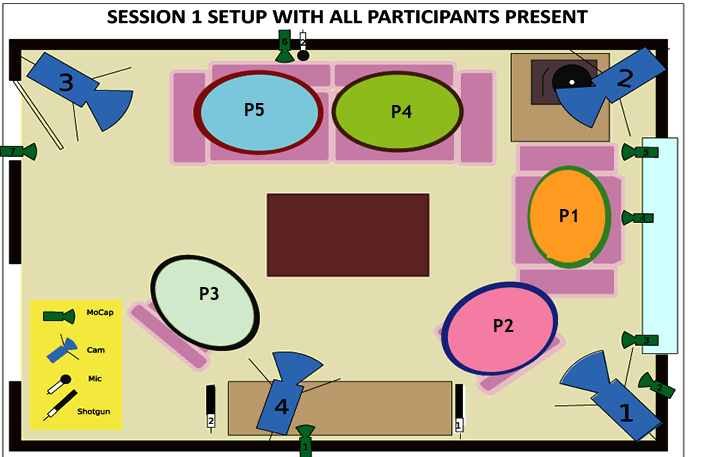d64 data
[row style=”margin: 20px 0px;”]
[column lg=”6″ md=”6″ sm=”12″ xs=”12″ ]
The corpus comprises 3 sessions. Sessions 1 and 2 were recorded on the same day with session 3 recorded on the following day. The recordings generated video files, audio files, and motion capture files.

[/column]
[column lg=”6″ md=”6″ sm=”12″ xs=”12″ ]
The room was arranged as in the image above, which shows the distribution of recording equipment for Session 1. Recordings were named by session, recording device, tape number – so S1C3002 is a video from Session 1 recorded on camera 3, and is the second of the camera 3 tapes for that session. Audio files were named for the microphone used (S1 = shotgun1) or for the person wearing them in the case of chest mikes. As most of the microphones were started at the same time, it must be noted that speech may be absent for quite a long time at the beginning of the recording. This is noted with recordings.
Participants
Five people were recorded. P1 and P2 knew each other as did P1 and P3 although P2 and P3 had not previously met. P4 and P5 knew each other well. P4 knew P1 and P3.
Timeline and Precis of corpus content
Under construction
[/column]
[/row]
Recordings
d64 audio and video
Audio and video for Sessions 1 and 2 of Day 1.
Timing and synchronisation
A database stores timepoints for all recordings, and offsets are used to synchronise the various media. The reference time used was the actual time of day, and all media timepoints are mapped to this ‘global’ time. For viewing several media simultaneously the offsets for each individual recoding’s ‘local’ start and stop times are used to synchronise playback.
| Title | Start Time | End Time | mp3 | 16kwav | 48kwav | Comment |
|---|
| Title | Start Time | End Time | mp3 | 16kwav | 48kwav | Comment |
|---|
